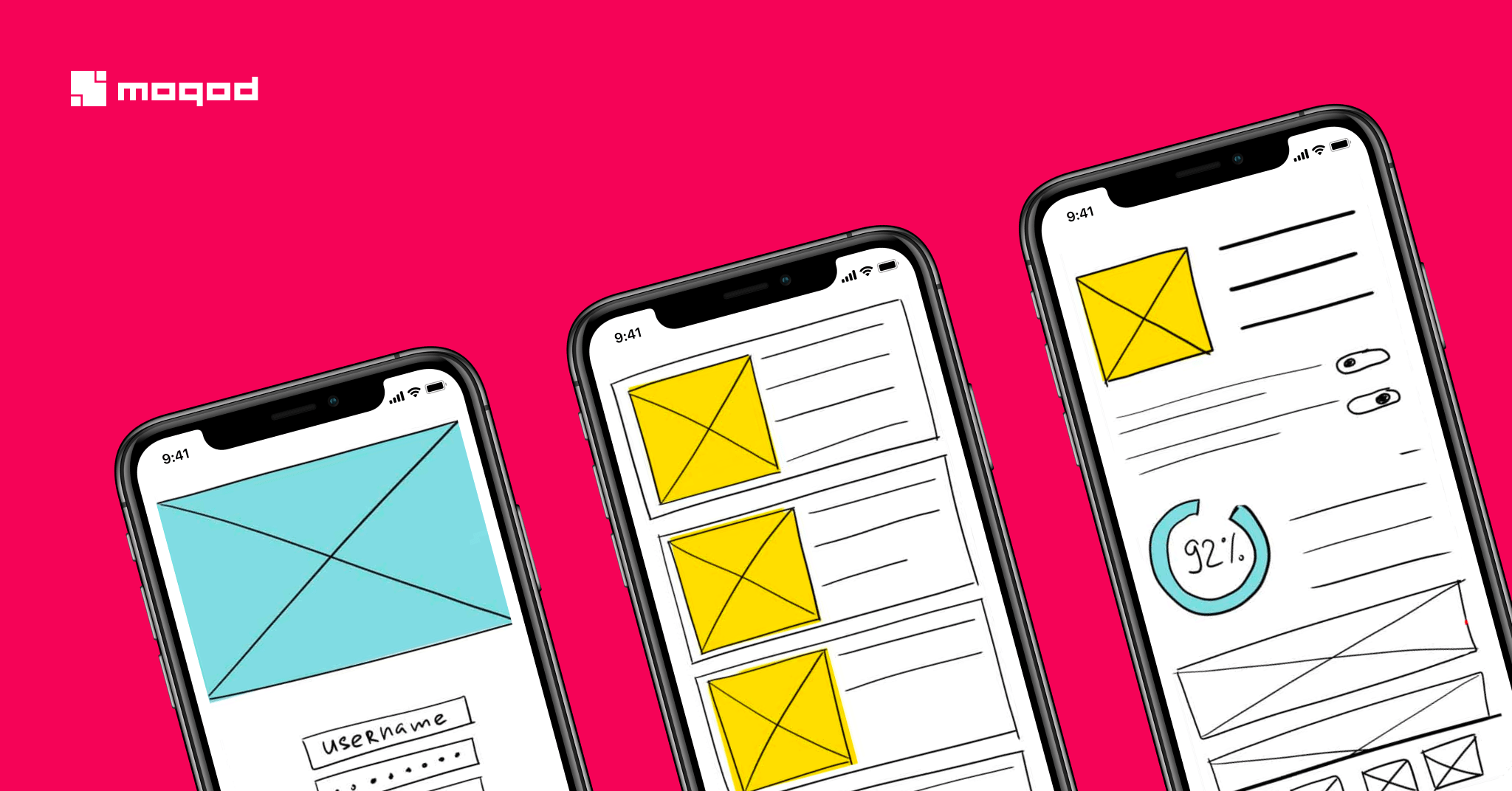
Rapid prototyping is one of the core phases of software development. It allows to tailor the final product to the user’s needs and launch the best possible version of the product. At Moqod, we consider rapid prototyping crucial for the success of your idea, which is why we place a special emphasis on it when we work with you.
What is rapid prototyping?
Rapid prototyping is the process where the designer creates a prototype that simulates the future application/website. A prototype is interactive, which is what makes it look and function almost like the final product. However, there is no actual working code behind the prototype, which is where the part ‘rapid’ comes from.
The goal is to design a very basic version of the product quickly (=rapidly) and give it to the goal audience, the team, and the client for testing.
When to use rapid prototyping in the agile process?
Rapid prototyping takes place during the UX/UI design part of development. It gives the end-users the feel of the product and allows them to give their feedback. A rapid prototype is not just a visual mockup because it focuses more on the user experience, while a mockup puts the user interface in the spotlight.
How is agile rapid prototyping different from the Waterfall method?
The Waterfall method is a process where each step is finalized before moving onto the next one. If you would like to add changes to a previously validated step, it is much harder to rewrite it using the Waterfall method. Not only do you have to go back and rewrite the step, but you also have to make sure that the changes don’t interfere with the following steps.
Think of it as a house of cards. To change one of the cards in the first row, you have to pull it out carefully and replace it with the right one, making sure the house doesn’t fall. With the Agile approach, you know that all the cards are the right ones before adding the top rows.
With Waterfall, there is very limited space for changes. The Agile approach allows adjustments, changes, and iterations in the process.
Don’t go chasing waterfalls if you want to focus on your end-user and go for sprints instead.
Rapid prototyping process
Rapid prototyping begins with defining the clear goal of the product/feature to validate. The customer and the provider agree on the final result. The finished product needs to fit the ideal customer, which is why rapid prototyping is a crucial part of the process. The question of this step is: “How does our product solve the user’s pain/problem”? Often you can answer this question by applying story mapping.
To get closer to the desired outcome, the customer and the provider brainstorm on the features and prepare the flow description in words. This will bring you closer to the users’ needs — outlining the decision-making process in the shape of user stories is an excellent way to proceed with this step.
During the next step of rapid prototyping, the designer takes on the job and designs a fully functional clickable prototype. He includes the features which the customer and the provider have agreed on.
The following step of the cycle is sharing the prototype with the team, the customer, the client, and the target groups.
A crucial step is to accept that it is very hard to hit the jackpot with the first design. Most likely, there will be adjustments, resets, changes, and pivots. This is not an obstacle — it is a detour in the right direction towards the ideal product.
The prototyping analysis can take shape in different forms. Think of it as finding the perfect road to get to your final destination: you want it to be efficient, fast, and with as few bumps as possible.
For example, the provider and the client may decide on A/B testing. If there are two options presented for a feature, the best way to pick one is to test them both, where A is the first option and B is the second one. By removing the less relevant options, you narrow down the features of your product to the perfect customer fit.
Another way to receive feedback on the prototype would be to collect the user data. Seeing whether the software is used in an expected way and how it is used allows to drop redundant functions and stick with the ones that smoothly bring the user to the final destination.
Contacting users directly for an interview and getting first-hand feedback is a very valid way to go. Make sure your interviewees are not your friends or relatives — you want to get objective, unbiased feedback. We have covered the subject of** the feedback** process and how to avoid being trapped in the ‘Mom phenomenon’ in our recent interview with Ewoud Uphof.
Once the feedback on the rapid prototype has been received, it is time to implement it. If the feedback corresponds with the initial vision of the goal, the team can proceed. In case if there are alterations needed, the team agrees on them and the designer creates a new version of the rapid prototype.
Advantages of rapid prototyping
The main advantage of rapid prototyping is that it focuses on the end user’s needs. Very often we tend to forget that our view of the problem and its solution is different from what our end customer has in mind. Rapid prototyping gets us into the user’s, allows us to get precious feedback, and tailor the product to the user’s need.
Rapid prototyping is extremely time- and money-saving in the long run. There is no code behind the prototype, so all the coding hours come after the features have been validated. Since the features correspond with the customer’s needs, there is little to zero chance that a lot of changes will be needed after the launch of the application/website.
How does rapid prototyping benefit the creation of an MVP?
It is common to confuse a rapid prototype with an MVP. However, a prototype is actually a key step towards an MVP.
An MVP is a standalone product with code behind it and it can be launched on the market. A rapid prototype focuses on UX design, it doesn’t involve any code-writing and it is not a viable product on its own.
Since the prototype is easy to modify and doesn’t have any code, it perfectly fits the Agile methodology. Think of it as a sketch or draft towards the launch of a first functioning product onto the market. There is a variety of tools on the market that allow you to test the design, prototype, and see how your product comes to life.
A prototype tests the user experience while the MVP tests both the user experience on a larger level and the market itself. This build-up towards the final product allows to make improvements faster and avoid changes once the product has been launched.
Potential pitfalls of rapid prototyping
The possibility to ‘rewind and adjust’ in rapid prototyping is a huge blessing that can also become a curse. While it is easier to modify a feature without re-writing the code, it is also easier to fall down the rabbit hole of perfection. Too many meticulous changes in the search for perfection can delay the delivery of the product and mess with the whole idea in general.
Another potential drawback of rapid prototyping is to go into too many details on the features right from the start. Both the client and the provider need to agree on the basic functions that will be tested during the rapid prototyping phase. Remember to keep it simple and stick to the main functions. Think of it as the skeleton, the basis. You will add the muscle and the nervous system later on.
At Moqod, we apply the Lean Startup method when it comes to rapid prototyping: we start with the basic features, we collect feedback on them and we improve all the time. Progress, not subjective perfection.
Rapid prototyping tools
On our projects, we work with different tools during the prototyping stage. These instruments consist form simple paper and pencil to more complex tools such as Figma, Zeplin, and Invision. Each of these ways has its ups and downs, but they all allow you to build a fully cross-functional and sufficient prototype.
Conclusion
Our view of rapid prototyping is battle-testing your application/website before the real battle on the market. We work with the best software to make sure we pinpoint your audience and save you both time and money. Our goal is not to bill you endless coding hours. Our goal is to create an efficient solution to make your business thrive and take your product to the spotlight it deserves.






